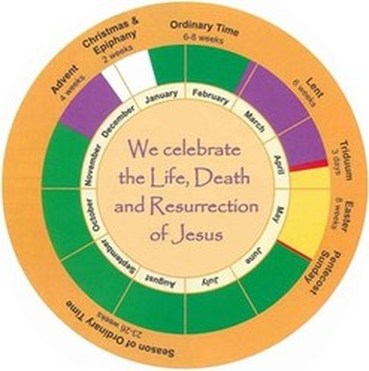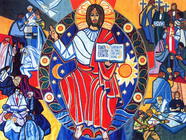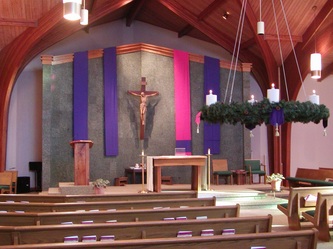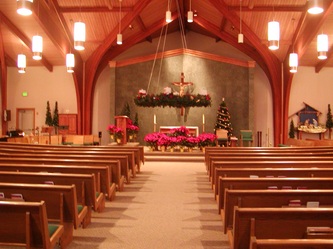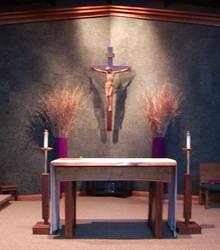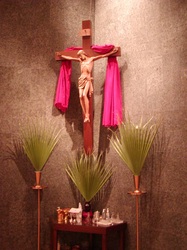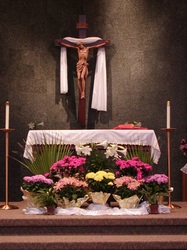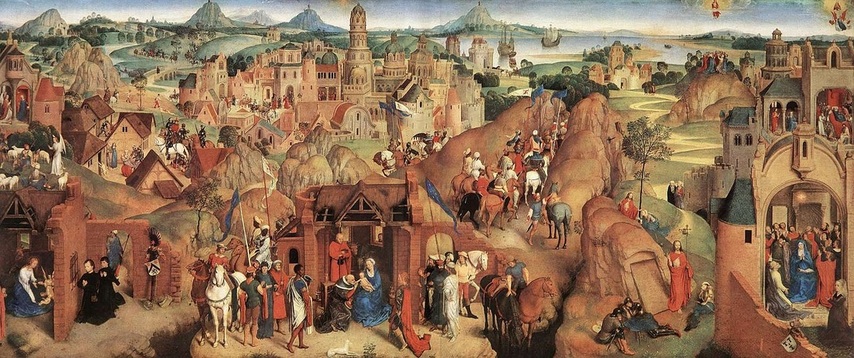Church Seasons & Celebrations
The Seasons of Our FaithThe liturgical year, or the church calendar, is the arrangement of the Church’s celebrations around the important events in the life of Christ. The church year begins on the first Sunday of Advent, the season of awaiting Christ’s coming and continues until the feast of Christ the King. From the time of the Apostles, Christians have gathered together on Sunday, the day of the Resurrection, to celebrate the Lord’s Supper. In the course of time, weeks were organized into two “seasons” which are Lent/ Easter and Advent/Christmas. Between the seasons of Lent/Easter and Advent/ Christmas we have two periods of non-seasonal time, “Ordinary Time,” so named for the Latin ordo, “the order of things.” |
Family Traditions There are many ideas in this section on the church year, to help your family grow closer to Jesus.
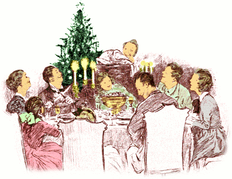
Find a few customs you would like to begin in your family.
It is important to begin traditions that point to God and
remind us of His loving involvement in our family lives.
Families with the strongest ties to one another
tend to have the most traditions because traditions
deepen a sense of security in the home.
Traditions establish family connectedness and rootedness. When we do something again and again over the years and we link the generations.
Traditions build family stability. Consistent family customs add an element of predictability to family life that's both comfortable and comforting.
Traditions cultivate family identity. Customs can give family members a sense of who they are and where they belong; "this is the way our family does it."
Traditions build family unity. Meaningful customs build a sense of closeness that endures even long after children are grown and gone.
Traditions reveal what is important in our lives. Observing special days and events allow us to share what is most important with our children.
Traditions symbolize how family members value one another. They convey: "I love you. I enjoy being with you. You are important to me."
www.paulthigpen.com
It is important to begin traditions that point to God and
remind us of His loving involvement in our family lives.
Families with the strongest ties to one another
tend to have the most traditions because traditions
deepen a sense of security in the home.
Traditions establish family connectedness and rootedness. When we do something again and again over the years and we link the generations.
Traditions build family stability. Consistent family customs add an element of predictability to family life that's both comfortable and comforting.
Traditions cultivate family identity. Customs can give family members a sense of who they are and where they belong; "this is the way our family does it."
Traditions build family unity. Meaningful customs build a sense of closeness that endures even long after children are grown and gone.
Traditions reveal what is important in our lives. Observing special days and events allow us to share what is most important with our children.
Traditions symbolize how family members value one another. They convey: "I love you. I enjoy being with you. You are important to me."
www.paulthigpen.com
Liturgical Colors
Each liturgical season has a special theme and meaning for worship which is reflected by a specific liturgical color. These colors are used for the priest's vestments and to decorate the church. The colors are a visual reminder of the event being remembered and celebrated, and help us spiritually align our hearts and minds accordingly.
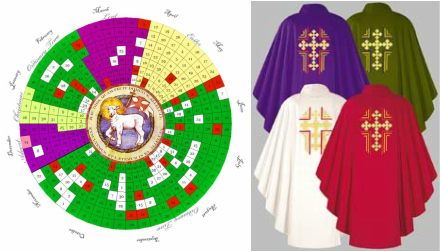
WHITE light innocence purity joy triumph glory
Season of Christmas
Season of Easter
Feasts of the Lord, other than His passion
Feasts of Mary, the angels and saints who were not martyrs
All Saints (1 November)
Funeral Masses
RED Christ’s Passion Holy Spirit God’s Love blood fire martyrdom
Feasts of the Lord's passion, Blood and Cross
Feasts of the martyrs - those killed for their Christian beliefs
Palm Sunday
Pentecost
GREEN life hope growth
Ordinary Time After Epiphany (last day of the Christmas Season)
Ordinary Time After Pentecost (last day of the Easter Season)
VIOLET penance humility expectation repentance
Season of Advent
Season of Lent
The difference between the penitential seasons of Advent & Lent:
Advent is the time to make ready for Christ to live with us. Lent is the time to make us ready to die with Christ. Advent makes Lent possible. Lent makes salvation possible. Advent is the time when eternity approaches earth. Lent is the time when time reaches consummation in Christ's eternal Sacrifice to the Father.
Advent leads to Christ's life in time on earth. Lent leads to Christ's eternal Life in Heaven. Fr. Lawerence Smith
Scripture Readings at Mass
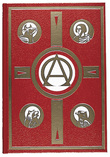
Sunday Readings
There are three sets of readings assigned for Sundays and other special days
throughout the church year. These readings are assigned to Liturgical Years A,
B and C. Years which are evenly divisible by 3 are assigned year C, such as
2010. Year A follows year C, Year B follows Year A, and Year C follows Year B.
The Liturgical Years start on the first Sunday of Advent of the previous year, so December 1, 2009 started Liturgical Year B.
Daily Readings There are two sets of readings for weekdays in ordinary time and other
special days throughout the church year. These readings are assigned to Liturgical Cycles I and II.
Odd years are assigned cycle I, and even years are assigned cycle II. Liturgical Cycles start on the first
Sunday of Advent of the previous year, so December 1, 1996, began Liturgical Cycle I.
There are three sets of readings assigned for Sundays and other special days
throughout the church year. These readings are assigned to Liturgical Years A,
B and C. Years which are evenly divisible by 3 are assigned year C, such as
2010. Year A follows year C, Year B follows Year A, and Year C follows Year B.
The Liturgical Years start on the first Sunday of Advent of the previous year, so December 1, 2009 started Liturgical Year B.
Daily Readings There are two sets of readings for weekdays in ordinary time and other
special days throughout the church year. These readings are assigned to Liturgical Cycles I and II.
Odd years are assigned cycle I, and even years are assigned cycle II. Liturgical Cycles start on the first
Sunday of Advent of the previous year, so December 1, 1996, began Liturgical Cycle I.
Each liturgical year brings us closer to God, connecting heaven and earth
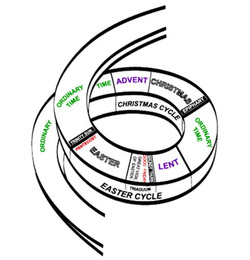
Every single year, we "re-live" the Gospel, from Christ's Birth to His Ascension and Heavenly reign.
In Spring He enters the world by coming to rest in Mary's immaculate womb; nine months later, in Winter, He is born, circumcised and given a Name. He is raised in the Holy Family, and meets His cousin, John. He goes into the Desert and we go with Him during our Lenten Season.
Then we follow His Passion and Agony which are soon vanquished by His Resurrection, His Ascension and the Pentecost. Now He reigns -- and forever, and we await His Second Coming as we prepare to celebrate again His First Coming.
Then the cycle begins again, like a wheel that's been spinning for two millennia. www.fisheaters.com
In Spring He enters the world by coming to rest in Mary's immaculate womb; nine months later, in Winter, He is born, circumcised and given a Name. He is raised in the Holy Family, and meets His cousin, John. He goes into the Desert and we go with Him during our Lenten Season.
Then we follow His Passion and Agony which are soon vanquished by His Resurrection, His Ascension and the Pentecost. Now He reigns -- and forever, and we await His Second Coming as we prepare to celebrate again His First Coming.
Then the cycle begins again, like a wheel that's been spinning for two millennia. www.fisheaters.com
St. Mary's Church throughout the Liturgical Year:
“Recalling the mysteries of redemption, the Church opens to the faithful the riches of the Lord’s powers and merits, so that these are in some way made present in every age in order that the faithful may lay hold on them and be filled with saving grace.” Constitution on the Liturgy
This painting by Hans Memling in A.D. 1480 -- depicts the life of Christ and, so, the Catholic's journey through the liturgical year, from Advent to Christmas, from Lent to Easter and Pentecost. The scenes include: The Annunciation, the announcement of the Nativity to the shepherds, the Nativity, the Slaughter of the Innocents, the Adoration of the Magi Christ and Mary Magdalen, the Passion, the Resurrection, the Ascension, the Pentecost, the Dormition (The Mother of God falling asleep) and Assumption of Mary.
Remembering Our Past Renewing Our Lives Transforming our Culture
To recall the past and remember is a universal human experience. We naturally celebrate past events in our own lives, beginning with birthdays. In Christian families, we recall anniversaries of marriage, ordination, religious profession and death. In the life of a city, nation or race great events are remembered and celebrated. This natural human focus on a "great event" was the cause and beginning of the development of the Liturgical Year. Just as the Passover in Egypt was the key to the Jewish calendar, so the Resurrection of Jesus of Nazareth, at the time of Passover around the Year 29 AD, was the cause and beginning of Christianity, Christians and the Church.
We face a rather different challenge in the Third Christian Millennium. In the mind of the Christian, each passing year takes shape, not so much around the cycle of natural seasons, the financial or sporting year or academic semesters, but around the feasts, fasts and seasons of the Catholic Church. Without thinking much about it, from early childhood, we gradually learn to see time itself, past, present and future, in a new way. The genius of the Liturgical Year is the way it reminds us that time was transformed when the Divine Word became flesh. We need to re-sacralize time in a secularized society that has abandoned our way of looking at the passing year.
-- Ceremonies of the Liturgical Year According to the Modern Roman Rite, Monsignor Peter Elliott
We face a rather different challenge in the Third Christian Millennium. In the mind of the Christian, each passing year takes shape, not so much around the cycle of natural seasons, the financial or sporting year or academic semesters, but around the feasts, fasts and seasons of the Catholic Church. Without thinking much about it, from early childhood, we gradually learn to see time itself, past, present and future, in a new way. The genius of the Liturgical Year is the way it reminds us that time was transformed when the Divine Word became flesh. We need to re-sacralize time in a secularized society that has abandoned our way of looking at the passing year.
-- Ceremonies of the Liturgical Year According to the Modern Roman Rite, Monsignor Peter Elliott
